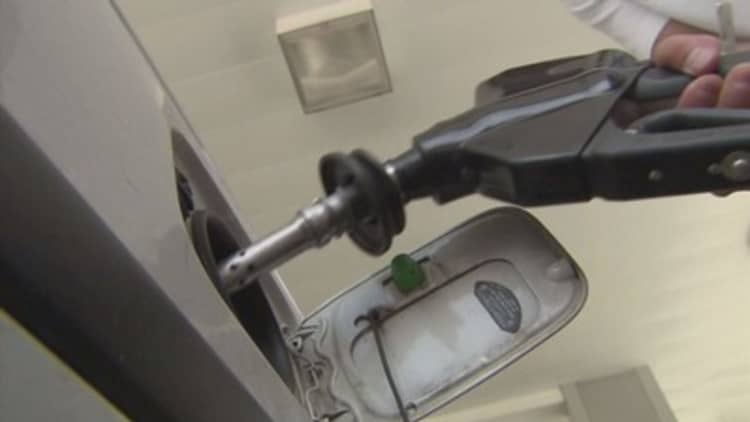
Gasoline prices could see a significant springtime jump of 20 to 45 cents per gallon, pushing retail pump prices to their highest level since June 2015, according to a widely followed gasoline analyst.
Tom Kloza, global head of energy analysis at Oil Price Information Service, said he sees several factors combining to push up prices — anticipated higher crude prices, higher demand from U.S. drivers and a higher level of gasoline exports. According to AAA, the national average for unleaded gasoline was $2.30 per gallon on Thursday.
"I'm not looking for consumers around the country to pay $3 or more, but I am looking for a noticeable increase that would put us 25 or 40 cents above the peak of last year, which was about $2.38," he said. That level was reached in June.
Kloza said macro factors support higher gasoline prices, including high employment, consumer purchases of SUVs instead of more fuel-efficient cars and strong consumer confidence, which jumped to a 16-year high this month.
"In looking back, I think we'll see retail prices that will be very similar to what we saw in 2015, when pump prices topped around $2.80 a gallon," he notes.
"Wherever we get to, it will represent an overreaction and we'll tend to slide lower in the last 100 days of 2017. But one can see where expenses for consumers may be $25 or so per month higher than they were during similar periods in 2016."
Kloza said global oil supplies appear to be rebalancing and demand for crude could soon outstrip supply, despite the huge amount of U.S. oil in storage. That should help prices, but so should demand for gasoline, which usually rises by about 100,000 barrels a day in April, though it fell last year.
He said there's also a calculation he uses that takes into account the span in futures prices for RBOB gasoline, which was about $1.26 per gallon in November. RBOB futures Thursday were at $1.68 per gallon.
"The average, over 30 plus years appreciation between the winter low for gasoline and the spring high … is 57 percent. … If you take the low, you get real close to $2 on the RBOB [gasoline futures] contract," said Kloza. Translated to retail prices, "It's in that $2.50 to $2.75 range at the pump with six states hovering around $3."
Some analysts don't see such robust gasoline prices this year, since U.S. gasoline demand has been soggy of late, and a gasoline glut in winter fuel has helped keep prices steady. But that flood of winter fuel should be waning, with a switch over to summer fuel starting April 1.
"There's no doubt that demand is going to pick up. Seasonally, we're out of winter and we're going to go into summer driving season, and demand is going to go up. The big question on everyone's mind is are we going to see an increase in demand compared to last year," said Andrew Lipow, president of Lipow Oil Associates.
U.S. gasoline exports have been rising and were 608,000 barrels a day last week, up from 400,000 barrels a day last year, according to the most recent Energy Information Administration data. Those exports go to Mexico and other locations in Central and South America.
Lipow expects oil prices to go up, contributing to a move higher in gasoline prices, which he sees just about 10 to 15 cents higher over the next couple of months. Oil prices could also get a lift from higher gasoline demand, as refineries use more crude.
"I think there's going to be strength in crude oil prices because over the next couple of weeks, we're going to continue to hear rhetoric from OPEC members wanting to extend their production cuts for the balance of 2017, and I think that's going to happen. Otherwise, the market would continue to be pressured under $50, which is not what they want," Lipow said.
West Texas Intermediate futures rose back above $50 Thursday, jumping 1.5 percent. Brent futures for May were trading just over $53 per barrel.
There are signs of tightening oil supply globally, said John Kilduff of Again Capital. Looking at the futures market for Brent crude, the international benchmark, there has been recent price movement.
"May [futures] pared its discount to June by 60 cents, indicating expectations for tighter physical market conditions," he said.
Watch: What happens when energy falls



